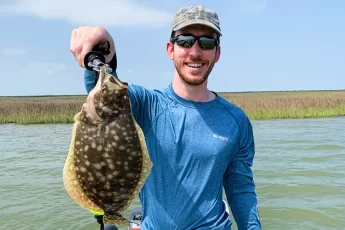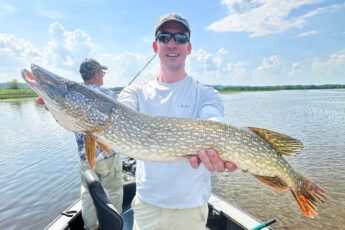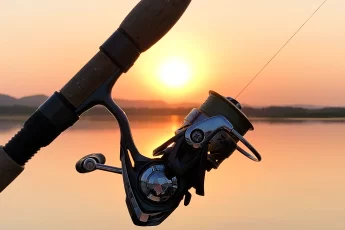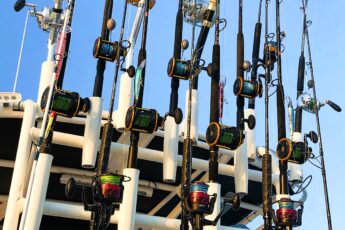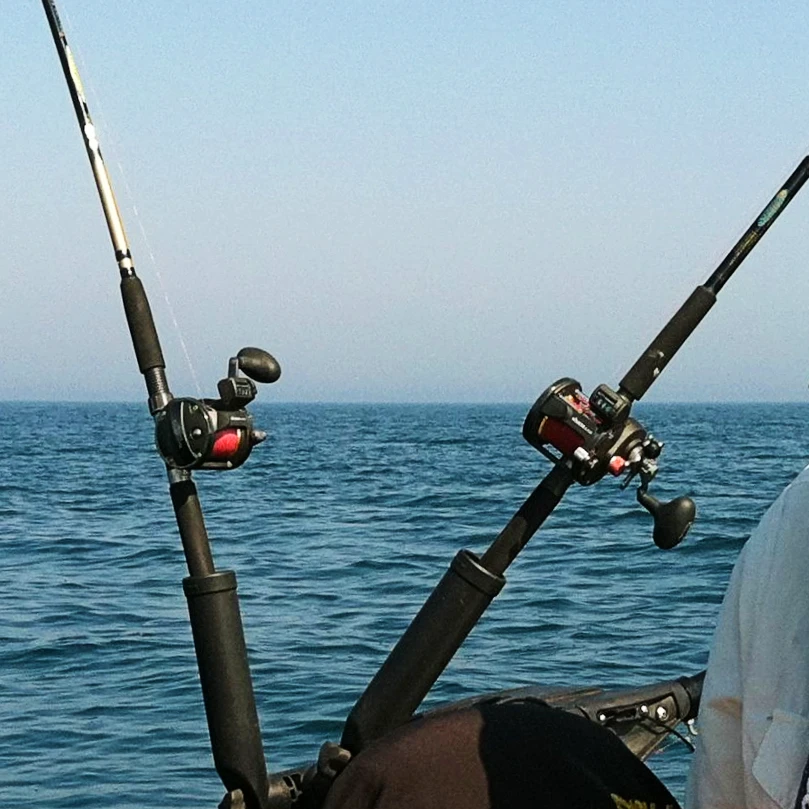
Updated 12/29/2023
The best trolling reels should be tough, reliable, high capacity, and provide a mechanism for depth control. Most trolling anglers prefer conventional reels for trolling because of their comparatively high drag ratings and high spool capacities. Other key considerations include drag type, level-wind, and line counter depending on target fish species.
Trolling is a popular fishing technique where baits suspended at various depths are pulled behind a moving boat. Anglers use this technique to target anything from walleye, salmon, pike, and musky in freshwater to tuna, king mackerel, mahi mahi, and marlin in saltwater.
In this article, we take a look at the top trolling reels on the market, considering factors like price, performance, quality, and value.
Whether you are a beginner or an expert angler, these reels are sure to meet your needs and help land your next big catch!
*Disclosure: I only recommend products I would use myself and all opinions expressed here are my own. This post may contain affiliate links that at no additional cost to you, I may earn a small commission.
Our Top 7 Picks
- Best for the Money: Shimano Tekota Line Counter Trolling Reel
- Best Under $200: Okuma Coldwater Linecounter Trolling Reel
- Best Under $100: KastKing ReKon Trolling Reel
- Best for Saltwater: Penn Squall II Level Wind Line Counter Conventional Reel
- Best Value Lever Drag: Penn Squall Lever Drag Conventional Reel
- Best Walleye Trolling Reel: Daiwa Sealine Conventional Reel
- Best Trolling Baitcasting Reel: Abu Garcia Revo SX Baitcasting Reel
The 7 Best Trolling Reels
Whether you’re a new angler or a grizzled expert, we have you covered. Check out our recommendations for best trolling reels by category like best budget and best for different price points!
1. Shimano Tekota Line Counter Trolling Reel
- Gear Ratio: 3.9:1 or 6.3:1
- Max Drag: 24 to 35 lb
- Drag Type: Star Drag
- Line Counter: Available on select models
- Ball Bearings: 3+1 or 4+1
- Weight: 15.5 to 30.7
Pros:
- Perfect trolling reel features
Our pick for the best trolling reel for the money is the Shimano Tekota Line Counter. Many anglers consider the Shimano Tekota as the gold standard of trolling reels. It’s reliable, built to last, has a high drag rating, high line capacity, and a great line counter. It is everything a trolling reel needs to be.
This reel is perfect for both freshwater and saltwater trolling. It’s comparatively lightweight due to its aluminum body.
The reel features Shimano’s CoreProtect for increased corrosion resistance and an oversized ergonomic handle to easily grip while reeling in big fish. The reel has a loud clicker which is great for detecting strikes while trolling.
This reel is built from high quality components and is an awesome choice for a trolling reel.
2. Okuma Cold Water Linecounter Trolling Reel
- Gear Ratio: 4.2:1 or 5.1:1
- Max Drag: 18 or 20 lbs
- Drag Type: Star Drag
- Line Counter: Yes
- Ball Bearings: 2+1
- Weight: 14.6 to 21.8 oz
Pros:
- Great quality for reasonable price
- Left and right handed models
Our pick for the best conventional reel under $200 is the Okuma Cold Water Linecounter Trolling Reel. This reel is well under $200 and excellent value for the price.
The Okuma Cold Water Reel is primarily marketed for salmon, steelhead, and walleye and has the perfect features to catch these fish. It has a reasonable max drag of 18 to 20 lbs, a stout gear ratio of 4.2:1 or 5.1:1, and even comes in left handed versions!
It comes with an aluminum spool, handle, and star drag. Okuma also offers a 1-year limited warranty on these reels.
The Okuma Cold Water Trolling Reel is a high quality, medium-duty trolling reel that is great value for the price.
3. KastKing ReKon Line Counter Conventional Reel
- Gear Ratio: 4.5:1 to 5.3:1
- Max Drag: 25 to 30 lbs
- Drag Type: Star Drag
- Line Counter: Yes
- Ball Bearings: 3+1
- Weight: 14.5 to 20.2 oz
Pros:
- Budget friendly price
- Star drag & level wind combo great for beginners
Our pick for the best trolling reel under $100 is the KastKing ReKon Conventional Reel. This reel surprised us with the number of premium features it has for the budget price point. The ReKon has a graphite frame, aluminum spool, brass gears, and brass worm gear.
The drag ratings from 25 to 30 lbs are competitive with higher end reels. We like the star drag and level wind combo for beginners because the level wind means the line automatically spools evenly and the star drag is versatile for small to medium sized fish.
This reel is a great budget entry point into conventional trolling reels. We recommend the size 10 for kokanee, walleye, and trout. The size 20 is great for larger fish like salmon, steelhead, lake trout, and striped bass. The size 20 has a much larger spool plus a large EVA foam power handle that is easier to bear down on for big fish.
4. Penn Squall II Level Wind Line Counter Conventional Reel
- Gear Ratio: 4.9:1
- Max Drag: 33 lb
- Drag Type: Star Drag
- Line Counter: Available on select models
- Ball Bearings: 3+1
- Weight: 16.8 to 24.7 oz
Pros:
- Robust and corrosion resistance
Our pick for the best trolling reel for saltwater is the Penn Squall II Level Wind Line Counter conventional reel. This reel is a purpose-built, saltwater trolling machine. The lower gear ratio allows for incredible torque to reel in large fish. The high 33 lb max drag is robust and can handle almost any fish in the water.
We recommend the level wind, line counter version of this reel as a premium trolling conventional reel for medium sized fish. This is a great setup for king mackerel, redfish, tuna, and mahi mahi.
For targeting the most massive species, like marlin, think about going with a reel with a lever drag and no level wind. Big fish can pull so hard they bind the level wind mechanism and a lever drag is generally preferred in those situations.
5. Penn Squall Lever Drag Conventional Reel
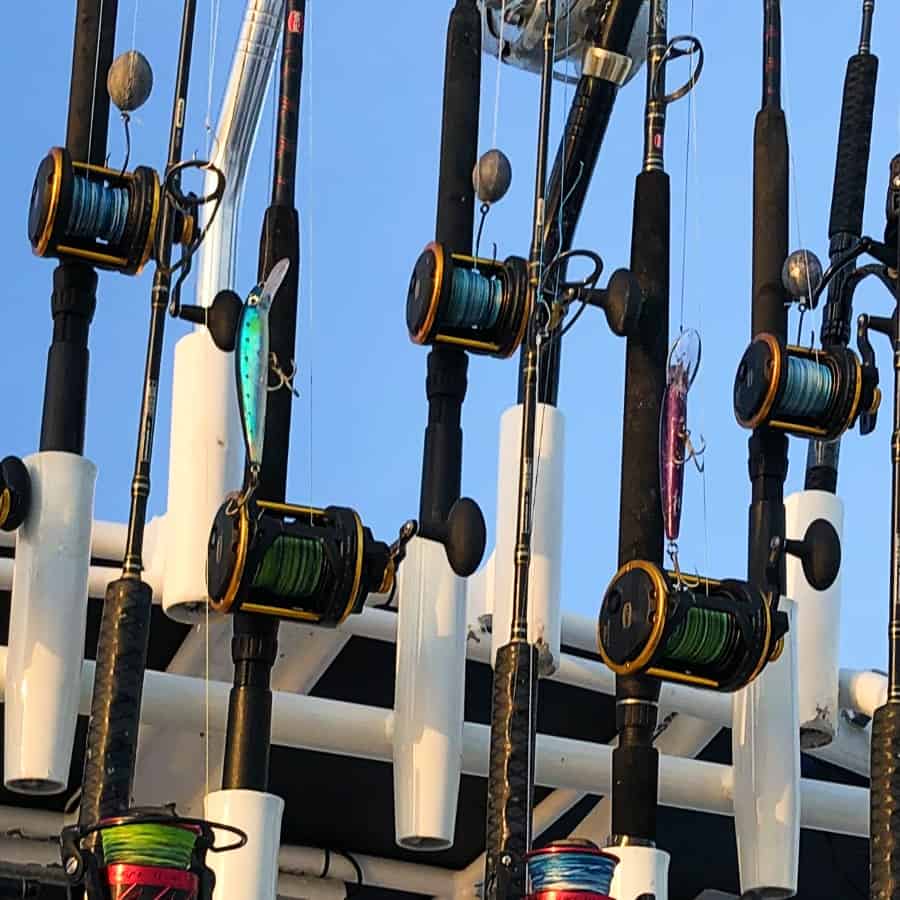
- Gear Ratio: 4.3:1 to 6.1:1
- Max Drag: 13 to 33 pound
- Drag Type: Lever Drag
- Line Counter: No, see the Squall II
- Ball Bearings: 6
- Weight: 18.2 to 28.1 oz
Pros:
- Great value lever drag reel
Our pick for the best lever drag trolling reel for saltwater is the Penn Squall Lever Drag Conventional Reel. This is a perfect lightweight trolling reel for nearshore trolling targeting kingfish and mahi-mahi.
We like 40 size for a great lighter duty trolling reel that also works great for snapper fishing. Grab the 50 or 60 for targeting kings, mahi-mahi, and tuna offshore.
The lever drag is great for line management with heavy baits and trolling rigs where there is a plenty of tension on the line. This reel does not have a line counter. It also does not have a level wind which is preferable for targeting huge trolling species because the level wind can increase friction on the reel and cause it to bind.
We picked the Squall Conventional reel for this list because it’s a straightforward, high-quality reel that is at an excellent price point.
6. Daiwa Sealine Conventional Trolling Reel
- Gear Ratio: 6.1:1
- Max Drag: 15.4 to 17.6 pound
- Drag Type: Star Drag
- Line Counter: No
- Ball Bearings: 3
- Weight: 15.5 to 19.6 oz
Pros:
- Perfect size and features for walleye trolling
- Budget friendly price
Our pick for the best walleye trolling reel is the Daiwa Sealine Conventional Reel. This is a budget friendly walleye trolling reel that has the features it needs to successfully troll for walleye. Since walleye don’t tend to stress equipment to its limits, like a marlin would, we recommend a budget friendly choice for walleye trolling.
The 20 and 30 size Daiwa Sealine conventional reels are great budget conscious trolling reel choices for walleye anglers. The Sealine is built with a high-tensile aluminum spool and marine bronze and stainless steel gears.
If looking to upgrade, we recommend the Shimano Tekota as our premium choice for walleye trolling reels.
Check out our article on our other favorite walleye reels for additional reading.
7. Abu Garcia Revo SX Baitcasting Reel
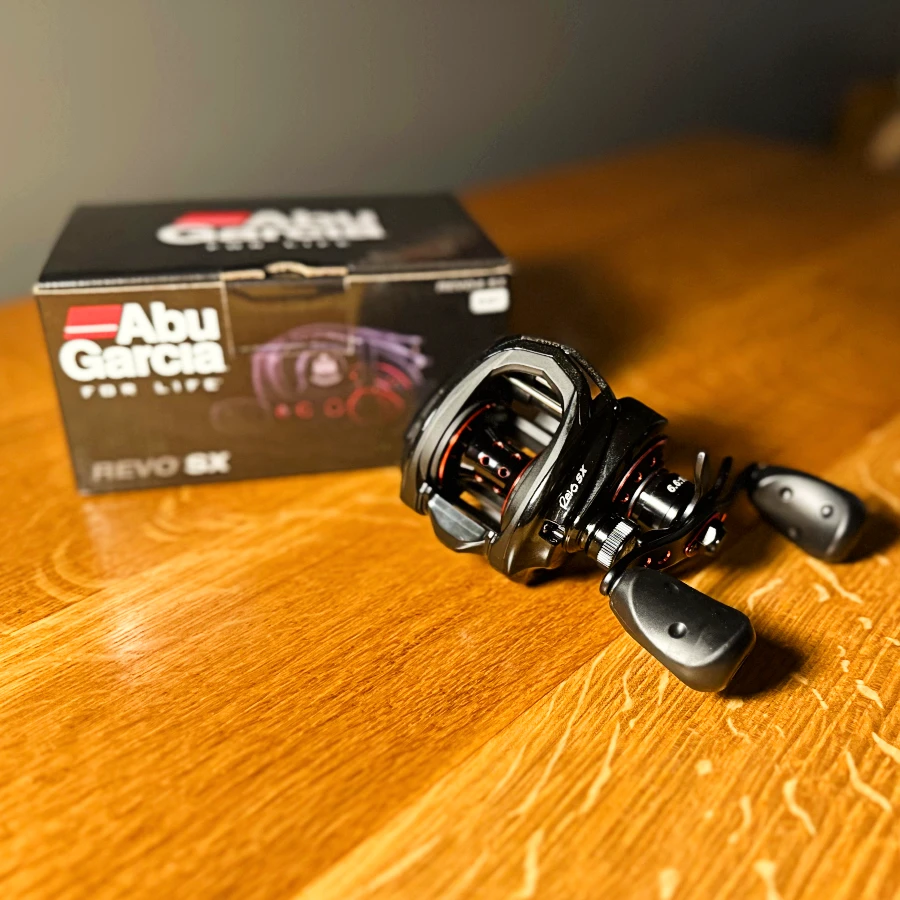
- Gear Ratio: 6.6:1 – 7.3:1
- Max Drag: 24 lbs
- Drag Type: Star Drag
- Line Counter: No
- Ball Bearings: 9+1
- Weight: 7.8 oz
Pros:
- Premium features at great value price
Our choice for the best trolling baitcaster reel is the Abu Garcia Revo SX. This is Abu Garcia’s most popular baitcasting reel for good reason. It’s lightweight, smooth, and a workhorse baitcasting reel.
We want to be clear, you do not NEED a conventional reel with a line counter for trolling. Regular baitcasting reels are perfect for light duty trolling. Baitcasters limitations include smaller spool capacities, lower drags, and a greater challenge in determining the exact depth of your bait when compared to conventional reels.
For light-duty trolling, like trolling for walleye with crankbaits, save yourself some money and repurpose your bass fishing baitcasting reels as functional trolling reels.
We picked the Abu Garcia Revo SX as our recommended trolling baitcaster because it’s a solid value proposition and has comparatively higher drag than many other baitcasters.
If looking to really splurge on a baitcasting reel for trolling, we recommend upgrading to the Penn Fathom Low Profile Reel because the Penn Fathom comes in much larger spool sizes and has a massive drag capacity for a low-profile baitcasting reel.
The Revo SX comes in both 6.6:1 and 7.3:1 gear ratios. Grab the 6.6:1 for excellent all-purpose fishing.
Check out our article on the best baitcasting reels for other great options.
Reel Comparison Table
Check out our handy comparison table showing key specifications for our top reel choices.
| Reel Name | Gear Ratio | Max Drag | Drag Type | Line Counter | Ball Bearings | Weight (oz) |
|---|---|---|---|---|---|---|
| Shimano Tekota Line Counter Trolling Reel | 3.9:1 or 6.3:1 | 24 to 35 lb | Star Drag | Available on select models | 3+1 or 4+1 | 15.5 to 30.7 |
| Okuma Cold Water Linecounter Trolling Reel | 4.2:1 or 5.1:1 | 18 or 20 lbs | Star Drag | Yes | 2+1 | 14.6 to 21.8 |
| KastKing ReKon Line Counter Conventional Reel | 4.5:1 to 5.3:1 | 25 to 30 lbs | Star Drag | Yes | 3+1 | 14.5 to 20.2 |
| Penn Squall II Level Wind Line Counter Conventional Reel | 4.9:1 | 33 lb | Star Drag | Available on select models | 3+1 | 16.8 to 24.7 |
| Penn Squall Lever Drag Conventional Reel | 4.3:1 to 6.1:1 | 13 to 33 pound | Lever Drag | No, see the Squall II | 6 | 18.2 to 28.1 |
| Daiwa Sealine Conventional Trolling Reel | 6.1:1 | 15.4 to 17.6 pound | Star Drag | No | 3 | 15.5 to 19.6 |
| Abu Garcia Revo SX Baitcasting Reel | 6.6:1 – 7.3:1 | 24 lbs | Star Drag | No | 9+1 | 7.8 |
Conclusion
In conclusion, having the right trolling reel is essential for a successful day fishing. There are many great options available, but the Shimano Tekota Line Counter Conventional Reel and Penn Squall II Level Wind Line Counter Conventional Reel stand out as our favorites. These reels offer a balance of performance, durability, and value that make them solid choices for trolling anglers.
Check out our articles for great rods to pair with these reels:
- Best Trolling Rods
- Best Saltwater Fishing Rods
- Best Mahi Mahi Rods
- Best Inshore Fishing Rods
- Best Walleye Rods
Check out our related reel articles:
- Best Conventional Reels
- Best Walleye Reels
- Best Baitcasting Reels
- Best Pike Reels
- Best Saltwater Baitcasting Reels
Buying Guide – How to Choose The Best Trolling Reel For You
Key factors for choosing the best trolling reel include reel size, drag type, line counter or not, level wind or not, build/material quality, and smoothness.
Reel Type
Conventional reels are considered the best for trolling spreads because they have large spool capacities, high drags, and additional features that are super useful for trolling like line counters and clickers.
Spinning reels and baitcasting reels can be used for trolling but may be hamstrung in comparison to conventional reels by smaller spool capacities, lower drags, or missing features.
Line Capacity
Line capacity refers to how much fishing line fits on the reel. The total spool capacity is specified by mono vs braid and line strength as pound test. An example line capacity would be “200 yards of 20-pound test braid”.
Braid is smaller diameter than mono at the same line strength which means you can fit more braid on a reel. Also, higher pound test line is larger diameter and will take up more space on the reel spool.
Line capacity is usually less of a determining factor for trolling reels and a big reason trolling anglers use conventional reels. Conventional reels commonly hold 300 yards or more of heavy-duty line. Spinning and baitcasting reels may only hold up to 150 or 200 yards of line which may not be enough for some trolling applications.
Line capacity is even more important if trolling anglers use lead core line. Lead core line is braided line wrapped around a lead core which gives the line additional weight to bring baits to the appropriate depth. This type of line is large in diameter and takes up quite a bit of space on a spool which also drives trolling anglers towards conventional reels with huge spool capacities.
Ball Bearings
Ball bearings in fishing reels are small, spherical bearings that reduce friction and increase smoothness of a reel’s operation. They are located within the internal mechanism of the reel and allow the reel’s moving parts to rotate smoothly against each other.
Most quality reels have at least four ball bearings. More ball bearings is usually better because the higher the number of ball bearings, the more friction is reduced and less wear and tear on the internal reel components. That said, ball bearing quality and material choice is also important. I would rather have four high-quality ball bearings than ten low quality bearings.
Most ball bearings are stainless steel but can also be ceramic. Many reels list something like “5+1 bearings” – this reel would be five ball bearings plus one roller bearing.
Drag System
Drag systems on fishing reels provide resistance to the spool as line is retrieved. A loose drag makes it easier for the spool to spin freely and a tight drag makes it difficult to rotate the spool.
Drag systems work using a series of washers or disks pressed together by a drag knob or level (usually on the top of spinning reels). As the drag is tightened, the drag washers are pressed together which increases resistance on the spool. Drag should be set to match the strength and size of the target fish species.
Setting the drag properly is an art. You want the drag tight enough to reel in the fish, but not too tight to where a strong pull could snap your line or cause your fishing knot to fail. When the drag is properly set, a strong pull from a fish should be able to pull some line from your reel.
A drag rating around 10 pounds is plenty for most inshore applications. For targeting larger fish or offshore, think of upsizing to 20 or 30 pound drag rated reels.
The two popular types of drag for conventional reels are lever drag and star drag.
Lever Drag
Lever drag reels use a lever on the side of the reel to the drag. These reels have preset drag positions that usually include free spool, bait, strike, and max settings but also allow for micro adjustments to really dial-in the drag. Lever drags are best used when targeting the largest fish, 30 lbs or larger, because drag settings can quickly be set for each phase of the catch. The common wisdom is the strike drag setting should be one third of the strength of the line. For example, 60-lb line should have a 20 lb strike setting.
Star Drag
Star drag reels can be identified by the star-shaped drag adjustment wheel just inside of the handle. They allow for on-they-fly adjustment and are a good option when it’s possible to hook into a variety of fish sizes that require different drag settings. Star drag reels are considered to cast slightly better than lever drags, but that’s usually not a big issue on high-quality reels. If targeting smaller fish, under 30 lbs, with a conventional reel, we recommend leaning towards a star drag. One downside of star drag reels is you can’t tell what the drag setting is just by glancing at the reel like you can with lever drag. For trolling for anything but the most massive fish, star drags are a great choice for trolling reels.
Gear Ratio
The gear ratio on a fishing reel refers to the relationship between the number of turns on the spool for every turn of the handle. For example, a gear ratio of 5:1 means the spool rotates five times for every turn of the handle.
Gear ratio is an important consideration when selecting a fishing reel because it affects the speed at which you can retrieve your line. A higher gear ratio is better for situations where you need to reel long distances or require fast bait presentations. A lower gear ratio is preferred for situations where a lower retrieval rate is desired, like when using finesse techniques.
Most reels have a gear ratio between 4:1 to 9.2:1. Conventional trolling reels tend to have slower gear ratios that allow for more torque and force to reel in huge fish. Between 4 and 6 to 1 are common gear ratios for conventional reels.
Level Wind
A level wind conventional reel is a reel that has a mechanism that evenly distributes line on the spool as the angler reels in. Most low-profile baitcasting reels having a built-in level wind system. Conventional reels can come with or without.
Level wind reels have pros and cons. The advantages of having a level wind reel is they are easier for beginners because the angler doesn’t have to manually distribute the line on the reel. The cons are, level wind systems can bind when reeling in massive fish and tend to have shorter casting distances than their non-level wind counterparts because of the friction caused through the level-wind mechanism. Since casting distance isn’t a major concern for trolling anglers, we recommend level wind mechanisms for most trolling applications.
Clicker
Clickers create an audible noise when a fish pulls line off the reel. A loud clicker is a nice feature so anglers have an indication that a fish is on. Generally the louder the better so that it can be heard over the engine and conversations.
Line Counters
Many trolling reels come with built-in line counters. Line counters allow the angler to precisely determine how much line has been paid out the spool which helps accurately set depths for trolling. Anglers that need precise depth control should think about getting a trolling conventional reel with a line counter.
Material Quality
Material quality is an important consideration for picking a conventional reel. Fishing reels are typically made of a combination of metal, rubber, and plastic parts. The body of the reel is usually made of aluminum or another type of metal to provide strength and durability. Plastic is used for many of the peripheral parts like the handle or drag knob because it is lightweight and corrosion-resistant.
Rubber seals may be used to protect against water, dirt, and sand ingress. High-end reels may have ceramic bearings or higher quality metal components.
Look for reels made of high-quality materials with solid, durable construction. Trolling conventional reels tend to be predominately metal because of their higher strength requirements to reel in huge fish.
Reel Brakes
Conventional reels have reel brakes. When you make a cast with a conventional reel, the momentum of the bait pulls line off of the spool. The spool rotates fastest at the beginning of the cast when forces are the highest. The reel brake slows down rotation of the spool to keep the fishing line tight on the spool and stop a backlash mess.
Brakes are important because if the spool rotates faster than the speed your bait is pulling out line, your reel will become a huge backlash mess.
There are three main types of brakes on fishing reels: centrifugal brakes, magnetic brakes, and digitally controlled brakes.
Centrifugal Brakes
Centrifugal brakes work by using a series of small weights that are pushed outward by centrifugal forces when the spool begins to spin. This increases resistance on the spool. To adjust centrifugal brakes, the side plate must be removed.
Magnetic Brakes
Magnetic brakes work by using a series of magnets to create resistance on the spool. They are considered more precise and higher quality than centrifugal brakes. Magnetic brakes are adjusted by a small dial on the side of the reel and can be fine tuned to adjust the resistance that is applied to the spool.
Digitally Controlled Brakes
Digitally controlled braking system utilize a microcomputer to monitor spool speed. The computer automatically applies the perfect amount of brake at superhuman speeds to prevent backlash. Digitally controlled brakes all but remove the ability for the reel to backlash.
Trolling Reel Frequently Asked Questions
What size trolling reel is best?
Anglers should match their trolling reel size to their target fish species and their preferred fishing technique. Freshwater anglers targeting walleye and salmon should get medium-sized trolling reels between 20 and 40 size. Offshore anglers targeting massive fish like tuna or marlin should get larger reels like 50 size or above. Larger reels can fit more line and larger diameter line.
What rod to pair with trolling reel?
Trolling reels should be paired with high quality casting rods chosen for their specific fishing technique. Boat anglers targeting huge fish should match their reel to a 5-7′ heavy-duty trolling rods. Rod action choice depends on the target species. Tough fish like tuna can be targeted with faster action rods. Softer-mouthed fish like salmon are better with slightly longer rods with more moderate actions so that there is more give in the system when a fish strikes.
How do you care for trolling reels?
Caring for trolling reels is important to ensure they perform their best and last a long time. Here are a few tips to take care of your reel:
- Rinse the reel with freshwater after each use to remove any salt, sand, or dirt
- Periodically lubricate the moving parts
- Store the reel properly in a dry protected place when not in use
What strength fishing line for trolling reels?
Trolling reels can use a wide range of fishing line strengths. 20 to 25 lb braid is a great option for freshwater trolling for walleye and salmon. Saltwater anglers should use anywhere from 40 to 130 lb braid depending on target fish species. Be sure to match the strength of the line to the size of the target fish. Smaller fish like tuna or mahi mahi can work on 40 lb braid whereas huge fish like marlin should use over 100 lb test line.
Is mono or braid better for trolling reels?
Braided fishing line is preferable for trolling reels. Braided line has significantly smaller diameter for the same strength line when compared to mono. This can be key for all kinds of fishing, because wind and current will constantly be pulling at your line. The smaller diameter means less effect from the elements. Additionally, you can fit more braided line than mono on the reel spool.
Since braid has very little stretch, many trolling anglers add a “top shot” which is 50-150′ of mono to their spools to put some give in the system. This adds a little bit of stretch so that when a fish strikes a trolling spread there is some built-in shock absorption that reduces the chances of losing fish.
How to switch reel from right to left handed?
Unlike most spinning reels, conventional trolling reels are not designed to switch from right to left handed and vice-versa. Conventional reels are ordered either right or left handed from the manufacturer.
Can you use a spinning reel for trolling?
Spinning reels can be used for trolling but may have limitations in spool capacity, drag rating, and limited depth control functionality. Larger size spinning reels, like 4000 series or higher, are recommended because they will have the spool capacity and drag strength to handle the requirements of trolling.
Can you use a baitcaster for trolling?
Low-profile baitcasting reels are functional for light duty trolling. Baitcasters limitations include smaller spool capacities, lower drags, and greater challenge determining exact depth of the bait when compared to conventional reels. When higher reel capacities and increased depth control are critical, we recommend swapping to a conventional reel.
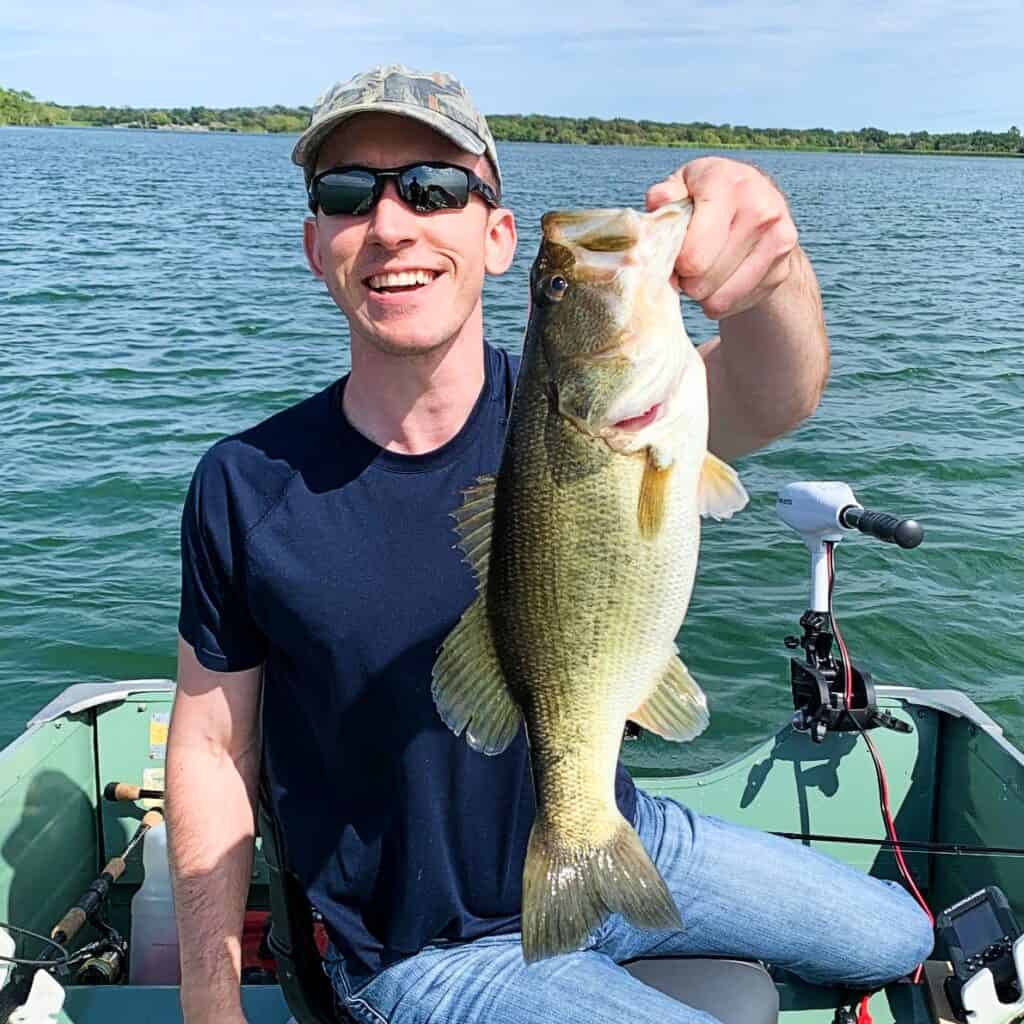
Written By: Andrew Juran
Andrew is a seasoned angler with over 25 years of experience fishing across the United States. He has caught hundreds of fish using various techniques and mentored many in the art of fishing. An advocate for sustainable fishing, Andrew is an active member of the Coastal Conservation Association, an organization committed to marine conservation.
For frequent fishing tips, behind-the-scenes looks, and real-time catches, connect with Andrew on Instagram







